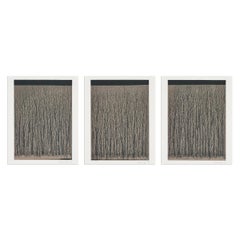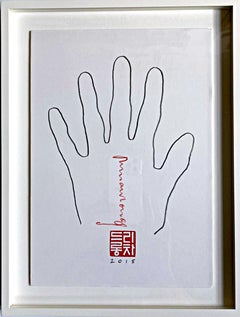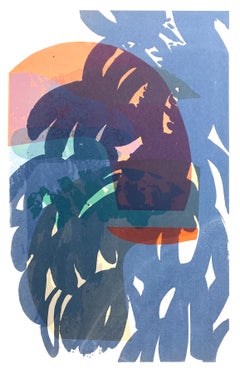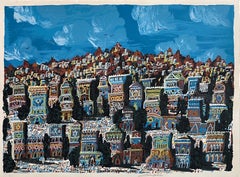Richard Long Art
to
2
1
1
2
1
1
1
1
Overall Height
to
Overall Width
to
1
1
1
1
1
1
1
1
2
1
4
6,938
3,292
2,514
1,213
2
1
1
1
1
Artist: Richard Long
Richard Long, Two Sahara Works - Set of 1 Grano Lithograph and 1 Silkscreen
By Richard Long
Located in Hamburg, DE
Richard Long (British, b. 1945)
Two Sahara Works, 1988
Medium: Set of 1 grano lithograph and 1 silkscreen, on rag paper
Dimensions: each 63 x 93 cm (24¾ x 36½ in)
Edition of 75: each...
Category
20th Century Land Richard Long Art
Materials
Lithograph, Screen
Richard Long, River Avon Mud Drawings - 3 Signed Prints, Land Art
By Richard Long
Located in Hamburg, DE
Richard Long (British, b. 1945)
River Avon Mud Drawings (from Sequences), 1998
Medium: The complete set of three grano-lithographs in colours, on Rives rag paper
Dimensions: 50 x 40....
Category
20th Century Contemporary Richard Long Art
Materials
Lithograph
Untitled (Artist's Hand), unique signed drawing by celebrated British artist
By Richard Long
Located in New York, NY
RICHARD LONG
Untitled (Artist's Hand), 2015
Graphite pencil on paper with red ink and monogram
Hand signed in red ink, dated in pencil, stamped with the artist's monogram
Unique
Orig...
Category
2010s Young British Artists (YBA) Richard Long Art
Materials
Ink, Pencil, Graphite, Mixed Media
Related Items
BRUSHWOOD - Modern Plants Unique Screen Printing 1/1 , Joyful, Colorful
By Anna Ładecka
Located in Salzburg, AT
Unique Screen Printing 1/1, signed by artist.
Anna Ładecka is a Paris-based polish illustrator and painter.
Graduated from Warsaw Academy of Fine Arts, Master of Art - Diploma in p...
Category
2010s Contemporary Richard Long Art
Materials
Screen, Archival Paper
Israeli Naive Art Screen Print Lithograph Jerusalem, Sanhedrin Old City Folk Art
By Gabriel Cohen
Located in Surfside, FL
Bold color lithograph, hand signed in pencil and numbered AP IX/X (artist’s proof 9/10), Jerusalem Print Workshop blind stamp lower right. On French Arches paper.
Gabriel Cohen, Self taught, Naive painter was born in Paris in 1933, to parents from Jerusalem with a father who studied the kabbalah. Throughout World War II, the family hid from the Nazis in Paris. Images of Nazi soldiers appear in several of his paintings. In 1949, when Gabriel was 16, the family returned to Israel. They managed to save enough money to move back to the quarter where both parents were born: Ohel Moshe in Nachlaot. Gabriel served in the artillery corps and after the army, went back to live in his parents' house and earned a living polishing diamonds. The head of the polishing plant, who noticed his employee's artistic skill, allowed him to paint during work hours. He once asked Cohen if he could draw a tiger. Cohen drew him a tiger. And he did a lot of sculpting and painting on glass. He also loved to play the guitar, especially flamenco style.
Critics say he is one of Israel's greatest naive-style painters. Along with Shalom of Safed, Kopel Gurwin and Natan Heber, He is renowned as one of Israel's greatest living naive-style folk art painters, recipient of the Jerusalem Prize for Art (1987), a permanent entry in encyclopedias of naive painting, who exhibited his work not only in Israel, but also in Paris, Venezuela, Denmark and Germany; the same Gabriel Cohen whose colorful , bold paintings were exhibited at the Jewish Museum in New York in 1987 alongside works by Marc Chagall; the same Gabriel Cohen about whom curator and art scholar Gideon Ofrat says, "There is no questioning his greatness."
He has shown in Paris on the Rue de Rosiers in the Marais. His impressions of his journeys, mostly imaginary, yet some real, are expressed in Cohen's paintings. Huge, colorful canvases rich in precise detail and fantasy, in which he paints the Eiffel Tower and the Russian steppes or the vistas of Paris and the Tower of Babel
"In my opinion, it's also because the Tower of Babel has some kind of phallic, erotic meaning, but also because of the internationalism, of the mixture and confusion of nations, which is an essential element in Gabi Cohen's work," says Gideon Ofrat.
There is no superlative that has not been lavished on Cohen's work by art critics, since he began showing his paintings at age 40, All the art critics seemed to agree at once that Cohen is one of the greatest naive-style painters in Israel. Their counterparts abroad seconded this view.
About a year and a half ago, Zadka organized a show for Cohen at the Jerusalem Artists' House. The Tel Aviv Museum bought a painting of Gabi's and so did the Israel Museum, and several artists bought his drawings. He is a great, great painter. There is no painter who is more of a symbolist and illustrative artist than he is. As a painter myself, I admire him." The Yom Kippur War in 1973 sparked an artistic breakthrough for Cohen; it was at that time that he began to sit on the sidewalk after his work as a diamond polisher and paint. Not long afterward, in early 1974, he did a painting he called "Moses on the Mountain." Ruth Debel, of the Debel Gallery in Ein Kerem, passed by and saw it on the street. She asked how much he wanted for it, and for the first time in his life, he realized that his work had financial value.
His first show was at the Debel Gallery in 1974. The response was overwhelming. Cohen was immediately declared a genius. His paintings at the gallery were purchased and he continued to create new paintings. That same year, he was invited to take part in a group exhibition of naive artists at the Kunsthaus in Zurich, and a year later, his work was included in a traveling show of naive-style artists from Israel that was exhibited in Denmark and Germany. Soon after that he was invited to be part of group shows in Venezuela and at the Tel Aviv Museum.
Cohen had four solo shows at the Debel Gallery.
Awards And Prizes
1987 Jerusalem Prize for Painting and Sculpture
1999 Shoshana Ish-Shalom Prize for special contribution to art, Jerusalem
He has exhibited alngside all of the Israeli great artists. including
Naive Art Group exhibition Gvanim Art Gallery, Jerusalem
Rubin, Rachel Roman, Yitzhak Zarembo, Leah Moscovitz, Shalom (of Safed) Steinberg, Michael Danisov, Salva Harbon, Haim Cohen, Gabriel Chanannia, Joseph (Jojo)
Local Hero...
Category
20th Century Folk Art Richard Long Art
Materials
Screen, Lithograph
Modernist Silkscreen Screenprint 'El Station, Interior' NYC Subway, WPA Artist
By Anthony Velonis
Located in Surfside, FL
screenprint printed in color ink on wove paper. New York City subway station interior.
Anthony Velonis (1911 – 1997) was an American painter and designer born in New York City who helped introduce the public to silkscreen printing in the early 20th century.
While employed under the federal Works Progress Administration, WPA during the Great Depression, Velonis brought the use of silkscreen printing as a fine art form, referred to as the "serigraph," into the mainstream. By his own request, he was not publicly credited for coining the term.
He experimented and mastered techniques to print on a wide variety of materials, such as glass, plastics, and metal, thereby expanding the field. In the mid to late 20th century, the silkscreen technique became popular among other artists such as Robert Rauschenberg and Andy Warhol.
Velonis was born into a relatively poor background of a Greek immigrant family and grew up in the tenements of New York City. Early on, he took creative inspiration from figures in his life such as his grandfather, an immigrant from the mountains in Greece, who was "an ecclesiastical painter, on Byzantine style." Velonis attended James Monroe High School in The Bronx, where he took on minor artistic roles such as the illustration of his high school yearbook. He eventually received a scholarship to the NYU College of Fine Arts, into which he was both surprised and ecstatic to have been admitted. Around this time he took to painting, watercolor, and sculpture, as well as various other art forms, hoping to find a niche that fit. He attended NYU until 1929, when the Great Depression started in the United States after the stock market crash.
Around the year 1932, Velonis became interested in silk screen, together with fellow artist Fritz Brosius, and decided to investigate the practice. Working in his brother's sign shop, Velonis was able to master the silkscreen process. He reminisced in an interview three decades later that doing so was "plenty of fun," and that a lot of technology can be discovered through hard work, more so if it is worked on "little by little."
Velonis was hired by Mayor LaGuardia in 1934 to promote the work of New York's city government via posters publicizing city projects. One such project required him to go on a commercial fishing trip to locations including New Bedford and Nantucket for a fortnight, where he primarily took photographs and notes, and made sketches. Afterward, for a period of roughly six months, he was occupied with creating paintings from these records. During this trip, Velonis developed true respect and affinity for the fishermen with whom he traveled, "the relatively uneducated person," in his words.
Following this, Velonis began work with the Public Works of Art Project (PWAP), an offshoot of the Civil Works Administration (CWA), where he was assigned to serve the different city departments of New York. After the formation of the federal Works Progress Administration, which hired artists and sponsored projects in the arts, he also worked in theater.
Velonis began working for the federal WPA in 1935. He kept this position until 1936 or 1938, at which point he began working in the graphic art division of the Federal Art Project, which he ultimately led. Under various elements of the WPA program, many young artists, writers and actors gained employment that helped them survive during the Depression, as well as contributing works that created an artistic legacy for the country.
When interviewed in December 1994 by the Library of Congress about his time in the WPA, Velonis reflected that he had greatly enjoyed that period, saying that he liked the "excitement" and "meeting all the other artists with different points of view." He also said in a later interview that "the contact and the dialogue with all those artists and the work that took place was just invaluable." Among the young artists he hired was Edmond Casarella, who later developed an innovative technique using layered cardboard for woodcuts.
Velonis introduced silkscreen printing to the Poster Division of the WPA. As he recalled in a 1965 interview: "I suggested that the Poster division would be a lot more productive and useful if they had an auxiliary screen printing project that worked along with them. And apparently this was very favorably received..."
As a member of the Federal Art Project, a subdivision of the WPA, Velonis later approached the Public Use of Arts Committee (PUAC) for help in "propagandizing for art in the parks, in the subways, et cetera." Since the Federal Art Project could not be "self-promoting," an outside organization was required to advertise their art more extensively. During his employment with the Federal Art Project, Velonis created nine silkscreen posters for the federal government.
Around 1937-1939 Velonis wrote a pamphlet titled "Technical Problems of the Artist: Technique of the Silkscreen Process," which was distributed to art centers run by the WPA around the country. It was considered very influential in encouraging artists to try this relatively inexpensive technique and stimulated printmaking across the country.
In 1939, Velonis founded the Creative Printmakers Group, along with three others, including Hyman Warsager. They printed both their own works and those of other artists in their facility. This was considered the most important silkscreen shop of the period.
The next year, Velonis founded the National Serigraph Society. It started out with relatively small commercial projects, such as "rather fancy" Christmas cards that were sold to many of the upscale Fifth Avenue shops...
Category
1980s American Modern Richard Long Art
Materials
Screen
Blimpie, America's Best Dressed Sandwich Pop Art Photo Realist Silkscreen Litho
By Charles Ford
Located in Surfside, FL
Charles Ford, American Photo Realist Pop Artist Texas Artist
Photorealism is a movement which began in the late 1960's, in which scenes are painted in a style closely resembling phot...
Category
20th Century Photorealist Richard Long Art
Materials
Screen
The City - Screen Print by Giuseppe Aleandro - 1980s
Located in Roma, IT
The City is an artwork realized in the 1980sy by Giuseppe Aleandro
Hand signed and numbered on the lower margin.
Mixed colored serigraph.
Edition of 16/150 prints.
Category
1980s Contemporary Richard Long Art
Materials
Screen
H 16.34 in W 35.44 in D 0.04 in
"#70 – I AM TIRED", ink, pencil, gouache, collage, vintage, hemingway, poetry
By Amy Williams
Located in Toronto, Ontario
"#70 – I AM TIRED" is from Amy Williams' series "A Farewell to Arms" – wherein the artist works directly onto page 70 of a found copy of Ernest Hemingway'...
Category
21st Century and Contemporary Contemporary Richard Long Art
Materials
Paper, Found Objects, Ink, Gouache, Pencil
Infanta IV: Figurative Cubist Abstract Graphite Drawing with Antique Frame
By David Dew Bruner
Located in Hudson, NY
Figurative abstract cubist style drawing inspired by the Infanta Margarita in an antique gold frame
“Infanta IV” by Hudson Valley artist, David Dew Bruner, made in 2015
23 x 18 inch...
Category
2010s Abstract Richard Long Art
Materials
Paper, Graphite
H 24.5 in W 19.25 in D 1 in
Peace Be Still
By Stanley Whitney
Located in London, GB
5 Colour lithograph on Somerset Satin Tub Sized White 410gsm.
60 x 76 cm (23.6 x 29.9 in)
Signed, dated and numbered by the artist
Edition of 125
‘Peace Be Still’ (2022) showcases S...
Category
2010s Contemporary Richard Long Art
Materials
Lithograph
"#220 – PEACE", ink, pencil, gouache, collage, vintage book, hemingway, poetry
By Amy Williams
Located in Toronto, Ontario
"#220 – PEACE" is from Amy Williams' series "A Farewell to Arms" – wherein the artist works directly onto page 220 of a found copy of Ernest Hemingway's W...
Category
21st Century and Contemporary Contemporary Richard Long Art
Materials
Paper, Found Objects, Ink, Gouache, Pencil
Snowflakes 84 Forester, Mandala Pencil Drawing, Owl, Cosmic Imagery, Landscapes
By Michiyo Ihara
Located in Kent, CT
A meticulously rendered owl at the center of this graphite drawing is the prominent feature of this mandala. Many cultures associate owls with wisdom, intuition and good judgment, a ...
Category
2010s Contemporary Richard Long Art
Materials
Paper, Graphite
H 25.25 in W 25.25 in D 1.5 in
Infanta XLVIII (Abstract Figurative Graphite Drawing in Antique Pewter Frame)
By David Dew Bruner
Located in Hudson, NY
Abstract graphite drawing on paper in vintage pewter frame
5.75 x 4.5 inches
This abstract figurative graphite drawing on paper was inspired by academic...
Category
2010s Abstract Richard Long Art
Materials
Paper, Graphite
H 5.75 in W 4.5 in D 1 in
Vladimir: Greek column abstract etching and screenprint, handmade paper frame
By Michael Hurson
Located in New York, NY
An abstract black and white shadowbox drawing of a Greek column, with a unique handmade, hand printed, leather brown wood grain frame. According to Roberta Smith, Michael Hurson "......
Category
1980s Contemporary Richard Long Art
Materials
Lithograph, Intaglio, Screen
H 23.25 in W 10 in D 2.25 in
Richard Long art for sale on 1stDibs.
Find a wide variety of authentic Richard Long art available for sale on 1stDibs. You can also browse by medium to find art by Richard Long in graphite, ink, lithograph and more. Much of the original work by this artist or collective was created during the 21st century and contemporary and is mostly associated with the contemporary style. Not every interior allows for large Richard Long art, so small editions measuring 5 inches across are available. Customers who are interested in this artist might also find the work of Tracey Emin, Ayse Wilson, and Lynne Fernie. Richard Long art prices can differ depending upon medium, time period and other attributes. On 1stDibs, the price for these items starts at $3,986 and tops out at $7,500, while the average work can sell for $5,743.




